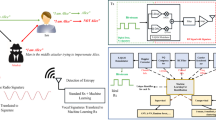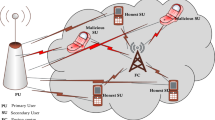Abstract
The technology of cognitive radio network (CRN) appears to be an excellent alternative for the efficient allocation of the frequency spectrum between the authorized and unauthorized users, in which the spectrum sensing plays a very significant role. It is often used to identify the availability of the primary user (PU) channel in its spectrum band. The probability of PU channels in high traffic CRN is usually high. While, the secondary user senses only those channels, in the predictive manner, which remain idle after prediction. In this paper, the impact of the collision factor has been considered, and it has been observed that without prediction, the throughput decreases as the collision factor increases. Therefore, the network has been trained through the neural network, based on the multi-layer perceptron model, to reduce the prediction error. After the spectrum prediction, the obtained results have established the improvement in SU's throughput.







Similar content being viewed by others
References
Jackson, D. S., Zang, W., Gu, Q., & Yu, M. (2015). Robust detection of rogue signals in cooperative spectrum sensing. J. Internet Serv. Inf. Secur., 5(2), 4–23.
Tragos, E. Z., & Angelakis, V. (2013). Cognitive radio inspired M2M communications. 16th International Symposium on Wireless Personal Multimedia Communications (WPMC), 1–5.
Zúñiga, V., Camuñas-Mesa, L., Linares-Barranco, B., Serrano-Gotarredona, T., & Rosa, J. M. d. l. (2020). Using neural networks for optimum band selection in cognitive-radio systems. In 2020 27th IEEE International Conference on Electronics, Circuits and Systems (ICECS), 1–4.
Jones, S. K., Phillips, T. W., Tuyl, H. L. V., & Weller, R. D. (2008). Evaluation of the Performance of Prototype TV-Band White Space Devices Phase II.
Haykin, S. (2005). Cognitive radio: Brain-empowered wireless communications. IEEE Journal on Selected Areas in Communications, 23(2), 201–220.
Mitola, J., & Maguire, G. Q. (1999). Cognitive radio: Making software radios more personal. IEEE Personal Communications, 6(4), 13–18.
Patel, D.K., Lopez-Benitez, M., Soni, B., & Garcia-Fernandez, A. F. (2020). Artificial neural network design for improved spectrum sensing in cognitive radio. Wireless Networks, 26, 6155–6174.
Liang, Y. -C., Zeng, Y., Peh, E. C. Y., & Hoang, A. T. (2008). Sensing-throughput tradeoff for cognitive radio networks. IEEE transactions on Wireless Communications, 7(4), 1326–1337.
Naikwadi, M. H., & Patil, K. P. (2020). A survey of artificial neural network based spectrum inference for occupancy prediction in cognitive radio networks. In 2020 4th International Conference on Trends in Electronics and Informatics (ICOEI) (48184), 903–908.
Jain, S., Goel, A., & Arora, P. (2019). Spectrum prediction using time delay neural network in cognitive radio network. In Smart Innovations in Communication and Computational Sciences (pp. 257–269). Springer.
Bhowmick, A., Roy, S. D., & Kundu, S. (2016). Sensing throughput trade-off for an energy efficient cognitive radio network under faded sensing and reporting channel. International Journal of Communication Systems, 29(7), 1208–1218.
Chatterjee, S., Maity, S. P., & Acharya, T. (2014). Energy efficient cognitive radio system for joint spectrum sensing and data transmission. IEEE Journal on Emerging and Selected Topics in Circuits and Systems, 4(3), 292–300.
Yang, J., & Zhao, H. (2015). Enhanced throughput of cognitive radio networks by imperfect spectrum prediction. IEEE Communications Letters, 19(10), 1738–1741.
Fong, K. L., Tan, C. K., & Lee, C. K. (2017). A reliable time-domain spectrum hole prediction for cognitive radio networks using regularized multi-layer perceptron. Wireless Personal Communications, 96, 647–654.
Bhowmick, A., Yadav, K., Roy, S. D., & Kundu, S. (2017). Throughput of an energy harvesting cognitive radio network based on prediction of primary user. IEEE Transactions on Vehicular Technology, 66(9), 8119–8128.
Kumar, D., Talukdar, B., & Arif, W. (2019). Performance analysis of prediction based sensing in energy harvesting cooperative CRN. In 2019 2nd International Conference on Advanced Computational and Communication Paradigms (ICACCP), 1–6.
Talukdar, B., Kumar, D., & Arif, W. (2019). Analytical modelling and performance evaluation of a prediction based EH-cooperative CRN under ERLANG distribution. In 2019 IEEE International Conference on Advanced Networks and Telecommunications Systems (ANTS), 1–6.
Thakur, P., Kumar, A., Pandit, S., Singh, G., & Satashia, S. N. (2018). Performance analysis of high-traffic cognitive radio communication system using hybrid spectrum access, prediction and monitoring techniques. Wireless Networks, 24, 2005–2015.
Bhuvaneswari, B., & Meeradevi, T. (2020). An optimised neural network-based spectrum prediction scheme for cognitive radio. International Journal of Enterprise Network Management, 11(1), 76–93.
Shaghluf, N., & Gulliver, T. A. (2019). Spectrum and energy efficiency of cooperative spectrum prediction in cognitive radio networks. Wireless Networks, 25, 3265–3274.
Tumuluru, V. K., Wang, P., & Niyato, D. (2012). Channel status prediction for cognitive radio networks. Wireless Communications and Mobile Computing, 12, 862–874.
Bhowmick, A., Prasad, B., Roy, S. D., & Kundu, S. (2016). Performance of cognitive radio network with novel hybrid spectrum access schemes. Wireless Personal Communications, 91, 541–560.
Author information
Authors and Affiliations
Corresponding author
Additional information
Publisher's Note
Springer Nature remains neutral with regard to jurisdictional claims in published maps and institutional affiliations.
Rights and permissions
About this article
Cite this article
Singh, A.K., Ranjan, R. Multi-Layer Perceptron Based Spectrum Prediction in Cognitive Radio Network. Wireless Pers Commun 123, 3539–3553 (2022). https://doi.org/10.1007/s11277-021-09302-5
Accepted:
Published:
Issue Date:
DOI: https://doi.org/10.1007/s11277-021-09302-5




